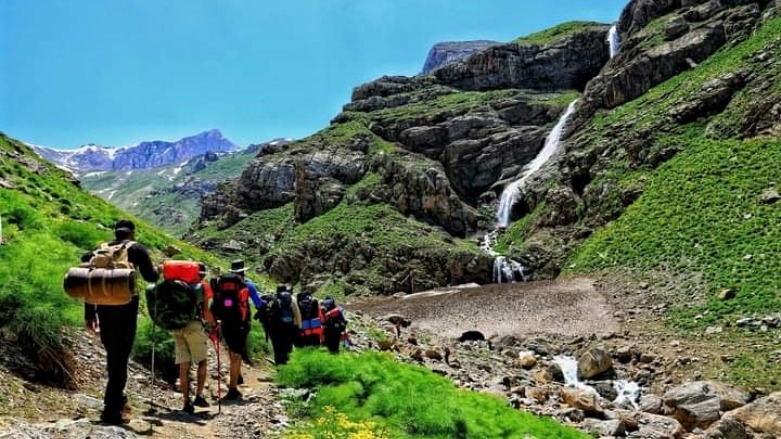Hikers enjoy breathtaking Kurdistan landscapes while avoiding landmines, border attacks

ERBIL (Kurdistan 24) – It isn’t wild animals nor natural disasters that Kurdish hikers fear most, it is the unexpected bombardment by two of Kurdistan’s neighboring nations and thousands of mines underfoot that were buried during the Iran-Iraq war in the 1980s.
Both challenges are formidable. Mines remain deadly for decades under the ground and both Iran and Turkey have never really stopped attacking areas along and well within the Kurdistan Region’s mountainous borders in their conflicts with various armed Kurdish opposition groups such as the Kurdistan Workers' Party (PKK) or the Democratic Party of Iranian Kurdistan (PDKI).
Some Kurdish hikers, however, have developed a system to safely return from their treks, safe and sound.
The Color and Voice of Kurdistan’s Nature (CVKN) is a hiking group in Kurdistan that ventures out at least three times a month in the rugged Qandil mountain range. It has 55 total members, at least 20 of whom join each individual adventure. Forty of the members are male and 15 of them female, all between 18 and 45 years old.

Hassan Luqman, 29, the group’s co-founder, says that unexploded ordinance and international border security are local hikers’ most significant hurdles because one can never predict the time or place of any incidents that may occur.
“You don’t know when they attack,” he remarks, explaining that this is part of the reason the group trains their members comprehensively before they participate and also make sure there are always experienced hikers on hand to act as tour guides.
To secure a safe hiking trip, CVKN makes sure it has their most experienced guides, seasoned backpackers, and always register their excursions with the Kurdistan Hiking Federation, which provides additional training and works to connect hikers with local law enforcement forces in the areas they pass through.
Read More: Mountain hiking club launches basic safety course in Kurdistan Region
“The Kurdish police and (other) security forces make sure we go and come back safely as they know which areas are safe to travel to.”
The CVKN has a medical team as well, which Luqman points out are all members of the group, so are on hand if medical assessments or treatment are required. But so far, he says, this has not yet been needed, something he chalks up to the fastidiousness with which they plan each trip, working hard to consider all possible scenarios before they shove off into the wilderness.
There are some 200 hiking groups in the autonomous Kurdistan Region, with most avoiding the riskier areas, especially ones with dormant landmines within the land.
The former Iraqi regime planted thousands of explosives in the Kurdistan Region and disputed territories during the 1980s to hinder the advance of Iranian troops, especially along the two nations’ shared border.
The eight-year war between the two neighboring states began in September 1980 and lasted until August 1988. Since 1991, many local and international mine-related organizations have contributed to the painstakingly slow and extraordinarily dangerous job of clearing explosives from tracts of land along the border. Large swaths of territory remain a danger to civilians as they have yet to be effectively de-mined or have only been partially cleared near major roads.
There remains an estimated 314 million square meters (121.2 million square miles) of affected land across the Kurdistan Region, according to the Iraqi Kurdistan Mine Action Agency.
Although such danger may deter other would-be trekkers, those in CVKN are not easily discouraged.
Foreigners join the hiking trips, too. Luqman told Kurdistan 24 that there are usually at least a couple of hikers from abroad each time they go. “The safety of our trips attract foreigners’ attention,” he says, as well as the fact that each member has at least three years of practical hiking experience in the terrain that covers the Kurdistan Region.

Those who participate regularly say they believe that doing so has completely changed their lives.
Berivan Azad, 20, says that she has learned to be strong and patient in other aspects of her life through her experiences with CVKN. She feels safe with her colleagues on the trail, she adds, because she trusts that they all know what to do to enjoy themselves while still being responsible.
“Hiking taught me how to never give up in life,” she says. “I learned to try, try, and try.”
Another enthusiastic member, 30-year-old Mamand Nabi, adds, “I know myself better and my stress level is much less since I’ve started hiking.”
It is true that there are mines and border security issues, Luqman says, but these adventurists never stop finding and appreciating the beauty of their homeland.
“Kurdistan is a paradise on earth,” he concludes. “Safety is our first priority, but having fun and living with nature is our second.”
Editing by John J. Catherine
